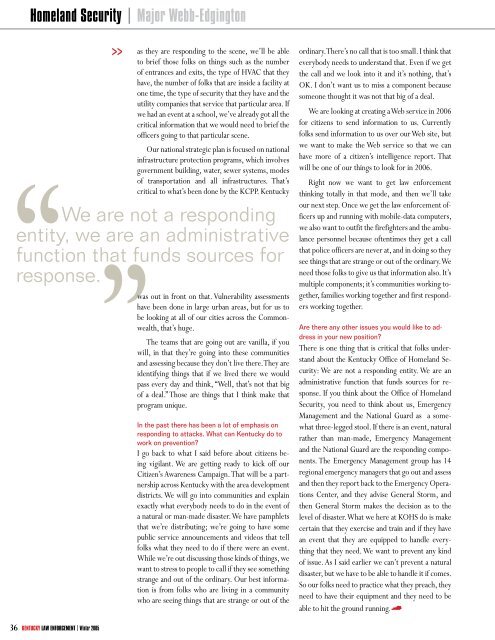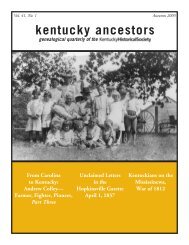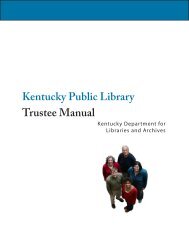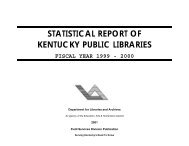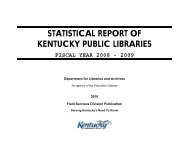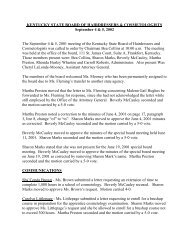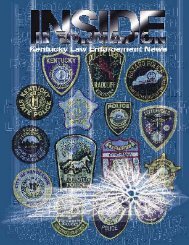4 - e-archives Home
4 - e-archives Home
4 - e-archives Home
You also want an ePaper? Increase the reach of your titles
YUMPU automatically turns print PDFs into web optimized ePapers that Google loves.
<strong>Home</strong>land Security | Major Webb-Edgington<br />
>><br />
as they are responding to the scene, we’ll be able<br />
to brief those folks on things such as the number<br />
of entrances and exits, the type of HVaC that they<br />
have, the number of folks that are inside a facility at<br />
one time, the type of security that they have and the<br />
utility companies that service that particular area. If<br />
we had an event at a school, we’ve already got all the<br />
critical information that we would need to brief the<br />
officers going to that particular scene.<br />
Our national strategic plan is focused on national<br />
infrastructure protection programs, which involves<br />
government building, water, sewer systems, modes<br />
of transportation and all infrastructures. that’s<br />
critical to what’s been done by the KCPP. Kentucky<br />
“We are not a responding<br />
entity, we are an administrative<br />
function that<br />
”<br />
funds sources for<br />
response.<br />
was out in front on that. Vulnerability assessments<br />
have been done in large urban areas, but for us to<br />
be looking at all of our cities across the Commonwealth,<br />
that’s huge.<br />
3 KENTUCKY LAW ENFORCEMENT| Winter 2005<br />
the teams that are going out are vanilla, if you<br />
will, in that they’re going into these communities<br />
and assessing because they don’t live there. they are<br />
identifying things that if we lived there we would<br />
pass every day and think, “Well, that’s not that big<br />
of a deal.” those are things that I think make that<br />
program unique.<br />
in the past there has been a lot of emphasis on<br />
responding to attacks. What can Kentucky do to<br />
work on prevention?<br />
I go back to what I said before about citizens being<br />
vigilant. We are getting ready to kick off our<br />
Citizen’s awareness Campaign. that will be a partnership<br />
across Kentucky with the area development<br />
districts. We will go into communities and explain<br />
exactly what everybody needs to do in the event of<br />
a natural or man-made disaster. We have pamphlets<br />
that we’re distributing; we’re going to have some<br />
public service announcements and videos that tell<br />
folks what they need to do if there were an event.<br />
While we’re out discussing those kinds of things, we<br />
want to stress to people to call if they see something<br />
strange and out of the ordinary. Our best information<br />
is from folks who are living in a community<br />
who are seeing things that are strange or out of the<br />
ordinary. there’s no call that is too small. I think that<br />
everybody needs to understand that. even if we get<br />
the call and we look into it and it’s nothing, that’s<br />
OK. I don’t want us to miss a component because<br />
someone thought it was not that big of a deal.<br />
We are looking at creating a Web service in 2006<br />
for citizens to send information to us. Currently<br />
folks send information to us over our Web site, but<br />
we want to make the Web service so that we can<br />
have more of a citizen’s intelligence report. that<br />
will be one of our things to look for in 2006.<br />
right now we want to get law enforcement<br />
thinking totally in that mode, and then we’ll take<br />
our next step. Once we get the law enforcement officers<br />
up and running with mobile-data computers,<br />
we also want to outfit the firefighters and the ambulance<br />
personnel because oftentimes they get a call<br />
that police officers are never at, and in doing so they<br />
see things that are strange or out of the ordinary. We<br />
need those folks to give us that information also. It’s<br />
multiple components; it’s communities working together,<br />
families working together and first responders<br />
working together.<br />
are there any other issues you would like to address<br />
in your new position?<br />
there is one thing that is critical that folks understand<br />
about the Kentucky Office of <strong>Home</strong>land security:<br />
We are not a responding entity. We are an<br />
administrative function that funds sources for response.<br />
If you think about the Office of <strong>Home</strong>land<br />
security, you need to think about us, emergency<br />
Management and the National Guard as a somewhat<br />
three-legged stool. If there is an event, natural<br />
rather than man-made, emergency Management<br />
and the National Guard are the responding components.<br />
the emergency Management group has 14<br />
regional emergency managers that go out and assess<br />
and then they report back to the emergency Operations<br />
Center, and they advise General storm, and<br />
then General storm makes the decision as to the<br />
level of disaster. What we here at KOHs do is make<br />
certain that they exercise and train and if they have<br />
an event that they are equipped to handle everything<br />
that they need. We want to prevent any kind<br />
of issue. as I said earlier we can’t prevent a natural<br />
disaster, but we have to be able to handle it if comes.<br />
so our folks need to practice what they preach, they<br />
need to have their equipment and they need to be<br />
able to hit the ground running. J


